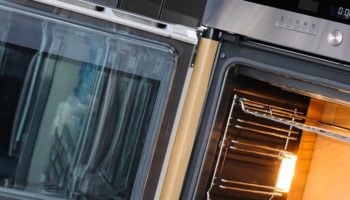Are you in the process of buying a new oven but feel overwhelmed by all the options?
That’s totally normal! In fact, whenever the time to replace home appliances comes around, many people tend to feel stressed and confused, especially when it comes to something that will last for a decade or two.
Ovens are not the cheapest appliances, so I can understand how you might be afraid to make the wrong purchase.
It’s estimated that the retail sales of major kitchen appliances in America amount to more than $90B every year, so you’re likely to be bombarded with a ton of information by the hundreds of companies that manufacture them.
So much information can easily become overwhelming and even cause you to make the wrong choice, leaving you with hundreds of dollars worth of repairs over time.
But don’t worry; you came to the right place for answers. With over 7 years of experience covering all things appliances, I’ve seen it all and want to share what I’ve learned with you.
Keep reading to buy the perfect oven!
Oven Types
Just as it happens with many other major appliances, several types of ovens exist. Each serves a different purpose and might be better suited to a person’s needs. Before going into the specific considerations of this ovens buying guide, let’s talk about what each model has to offer.
Range Ovens
Range ovens are, in my opinion, ideal for homes that require versatility, as they combine an oven compartment and a cooktop. The all-in-one configuration offers two separate cooking solutions under a single appliance, which can be very useful, especially considering that you can use them both at the same time.
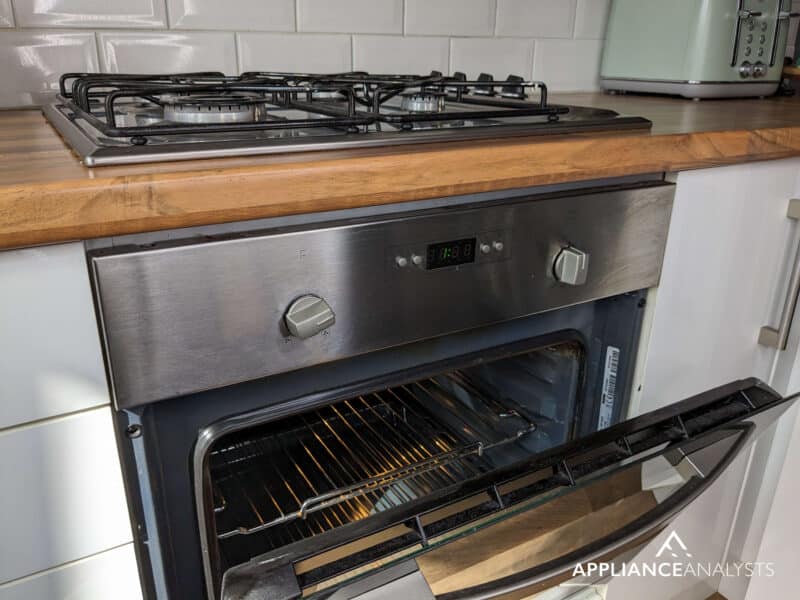
Within the category of range ovens, there are 3 main subdivisions:
- Freestanding: Freestanding variants can be placed as a standalone piece in your kitchen or as part of your cabinetry.
- Slide-In: Slide-ins are designed to be placed between cabinets to offer a seamless look.
- Double Oven: Double ovens are great for cooking multiple meals at the same time, as they feature 2 separate oven compartments that can be controlled individually.
Range ovens are ideal for smaller homes with reduced kitchen spaces, as the integrated design of the appliance provides convenience. If you live with 1–2 more people, an average range oven will do the job just fine.
Depending on the size and model you go for, you can typically find range ovens that cost anywhere between $400-2,000.
Wall Ovens
Wall ovens could not be missing from this ovens buying guide.
Wall ovens are typically mounted into a special cabinetry or section within your kitchen. The design is not only meant to save space and contribute to the aesthetic of your home but also to make baking much easier, as they can be placed nearly anywhere – often at eye level.
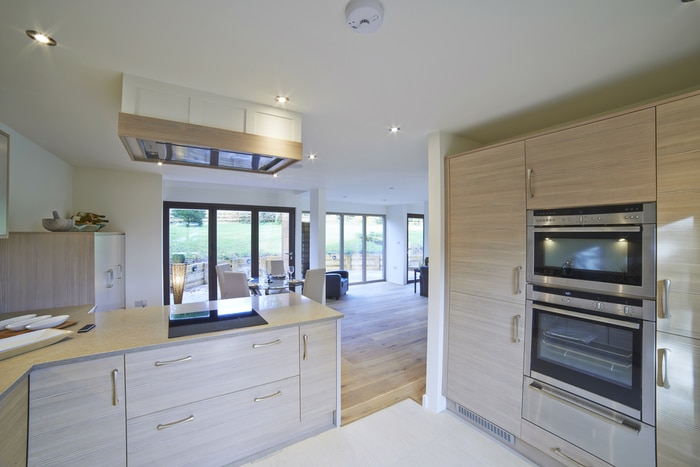
Moreover, wall ovens tend to have larger compartments than their range counterparts, which is great if you’re used to baking in big batches.
Not unlike range ovens, wall ovens can also be subdivided into a couple of variants:
- Single: A wall oven with one compartment to place and cook meals.
- Double: A variant that offers two different cooking compartments for preparing multiple dishes at the same time.
Most wall ovens will meet your needs as well as any range unit; however, if you have a specific idea for your kitchen, a wall oven might be the one for you.
I find that wall ovens are a bit more expensive, as you won’t only be paying for the appliance but also for the installation into your cabinetry and all the wiring that comes with it. You should expect to pay anywhere between $600-3,500 or more, depending on how sophisticated you want your oven to be.
Gas Ovens
Gas ovens were the most common for decades, as they were the most popular option before their electric substitutes came along. And in this ovens buying guide, you’ll find that, even today, gas ovens are still in demand.
In my experience, gas ovens are great for people who don’t want their baking to add up to their electricity bill month after month.
That said, it should be mentioned that gas ovens typically require more maintenance than their electric counterparts, as you need to be constantly aware of possible leaks.
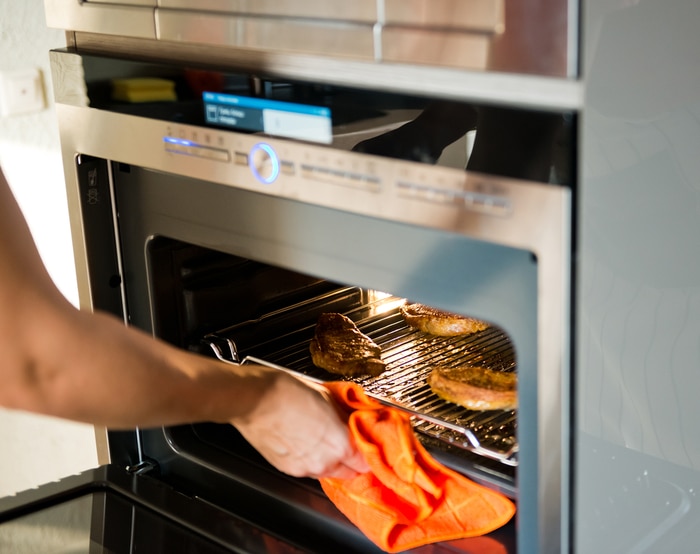
Since all oven types can be gas-fueled, their price tag can vary greatly depending on your choice. A range gas oven might cost you as “little” as $500 or as much as +$3,000 if it’s a Smart variant.
Electric Ovens
Electric ovens are much more modern and eliminate the fire hazard of gas alternatives. Not to mention that electric ovens are typically less demanding in terms of maintenance. However, like any other appliance, I find that electric ovens also have their fair share of Cons.
Depending on the cost of energy sources in different living areas, some people might be better off purchasing an electric oven over a gas model if savings are a significant concern. Generally, electric ovens are right for people who don’t know their way around DIY appliance repairs and don’t wish to get involved in constant maintenance efforts.
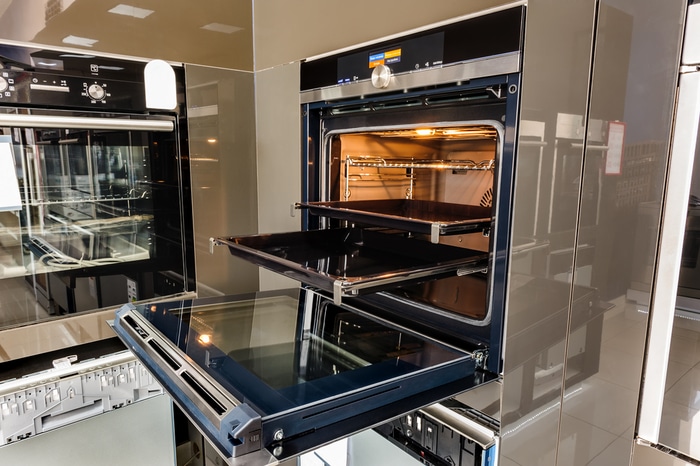
An average electric oven for a household of 2–3 people should go for anywhere between $500-2,200. However, as with gas models, all oven types can be electric, so depending on your choice, you might end up paying more than $3,000.
Convection Ovens
Convection ovens run on electricity, gas, or sometimes even steam. However, there’s a big difference between convection ovens and others – how they cook meals. While “regular” ovens produce sweltering temperatures inside their compartment, convection alternatives also use a fan to circulate the hot air trapped inside to deliver a more consistent and even result.
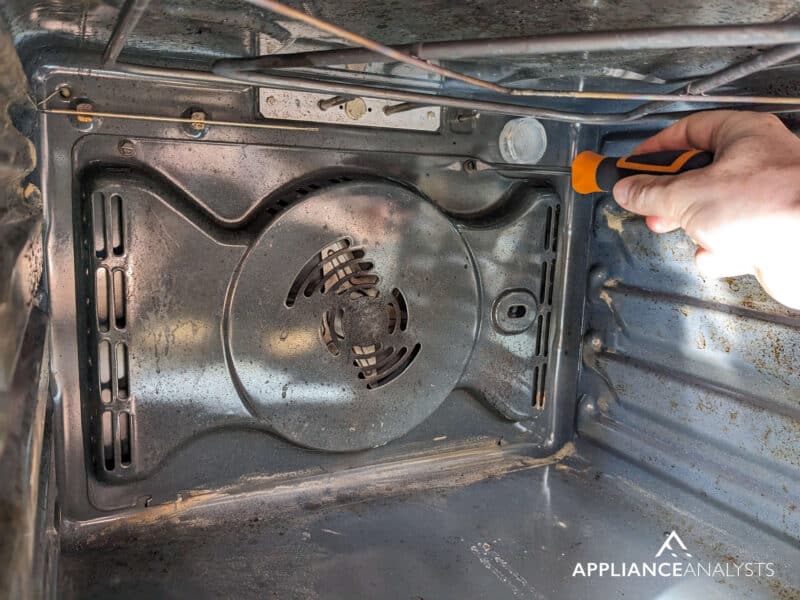
Convection ovens are great for perfectionists and can be found in all sizes, so regardless of the number of family members you have, you’ll certainly be able to pick one that meets your needs.
On average, you should expect to pay anywhere between $1,000-2,000 for a convection oven. However, if you want the best of the best, the sky’s the limit regarding pricing.
Smart Ovens
Smart ovens offer their owners all sorts of possibilities, automatic configurations, and even remote control features via their smartphones. Technology is constantly advancing, simplifying tasks, and automating nearly anything, so who knows what will be the next big thing?
Maybe your next oven will even prepare your meals from scratch!
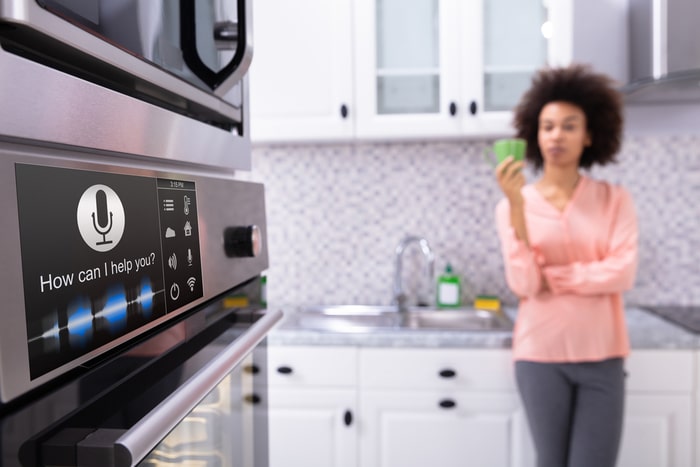
Tech does not come cheap, so if you’re interested in getting a high-end model to show your friends, you’ll have to take considerable money from your piggy bank. On average,
Smart ovens are in the $600-3,500, and they’re ideal for people who want to bake while being able to move freely around their home while making any adjustments necessary.
Air Frying Ovens
Air fryers have a fan that circulates the hot air within them to ensure even cooking and the mouth-watering Maillard reaction on your meals. Typically, Air-Frying ovens offer air frying as a feature rather than being based entirely on this particular cooking method.
Air-frying ovens are perfect for people who like to eat healthier recipes and have complete control over the cooking process of their food, so they had to be included in this ovens buying guide.
More often than not, ovens with air-frying capabilities are designed to offer alternative cooking methods as well, so if you like versatility and a friendly price tag, an Air-Frying oven is for you.
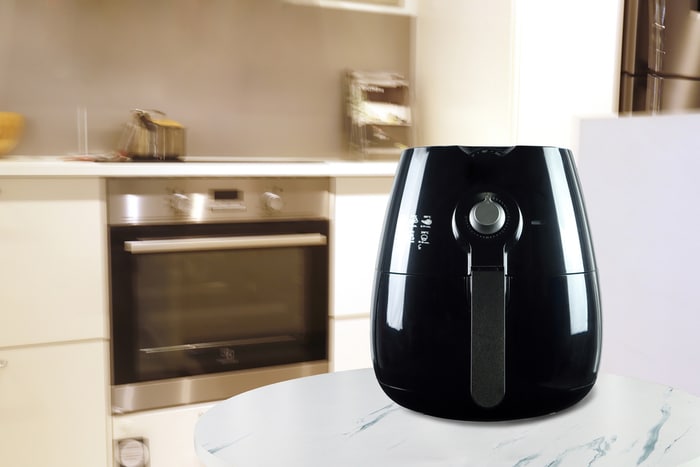
Depending on your chosen model, you might end up paying anywhere between $100-300 for an Air-Frying oven. However, if you want a full-sized oven that offers air frying, you’ll end up paying many times the abovementioned amount.
Steam Ovens
Steam ovens cook your meals and deliver results that are not entirely possible through heat alone by using… you guessed it – steam.
Steam ovens ensure that typically dry white meats retain as much moisture as possible. Moreover, steam ovens are also very good at baking bread and even reheating leftovers, as they don’t dry them out as other ovens would.
Not to mention that since steam ovens use lower temperatures, they tend to be more energy-efficient than electric or gas models.
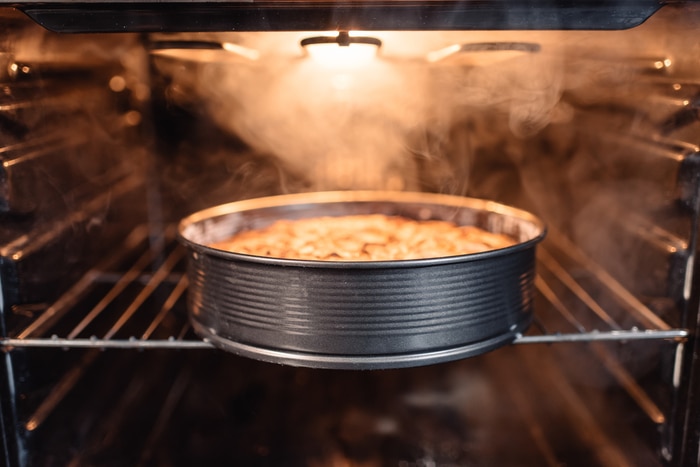
Steam ovens are great for people who want to save on utilities and get faster cooking times. The only disadvantage is that you’ll have to pay anywhere between $600-5,000 for a steam oven, so if you came to this ovens buying guide thinking of savings, this oven type might not be for you.
What to Consider When Buying
Now that you know all the different oven types available on the market, we can go deeper into the main factors you should take away from this ovens buying guide.
Price
Price is probably the first thing that comes into most people’s minds when looking an ovens buying guide and for good reason. Appliances these days are very expensive, and since ovens, as opposed to toasters or blenders, tend to last for at least a decade, making sure you get the biggest bang for your buck is key.
The larger and more complex an oven type is, the more expensive it will be.
To give you a clearer perspective on what you can expect to pay for different oven types, here’s a detailed table for your consideration:
| Oven Type | Low-end | Average | High-end |
| Range Oven | $450 | $1,475 | $2,500 |
| Wall Oven (Single) | $420 | $1,660 | $2,900 |
| Wall Oven (Double) | $1,200 | $3,100 | $5,000 |
| Convection Oven | $1,000 | $2,300 | $4,500 or more |
| Smart Oven | $600 | $2,550 | $5,000 or more |
| Air-Frying Oven | $150 (smaller units) | $800 | $3,700 or more |
| Steam-Oven | $700 | $2,000 | $4,000 or more |
Capacity
Capacity is another essential element you must consider before buying a new oven, as it will determine whether you spend countless hours baking or a little under an hour every day.
Ideally, you want to have as much space as possible to place your food inside your appliance; however, space comes at a price, so the higher the storage capacity of an oven, the more it will cost.
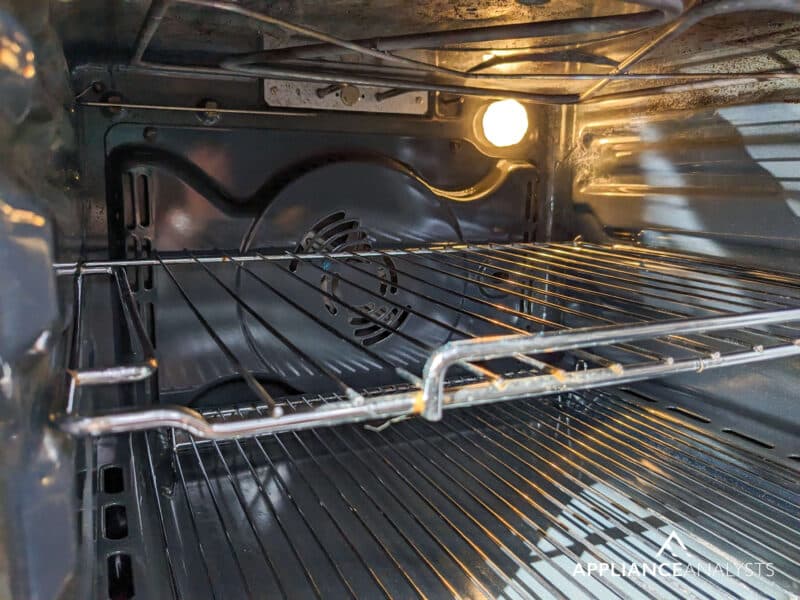
Now, don’t worry. If you live alone or have a small family, an average-sized oven compartment should cover most of your needs with room to spare.
| Family Members | Recommended Oven Space |
| Up to 3 | 3 cubic ft. |
| 4 or more | 5 cubic ft. or more |
Fuel Type
Fuel type is also a critical element to consider, as it will determine how much you’ll be paying month after month to run your oven. Often, people only look at the price tag on the appliance they’re purchasing without ever thinking about its associated cost.
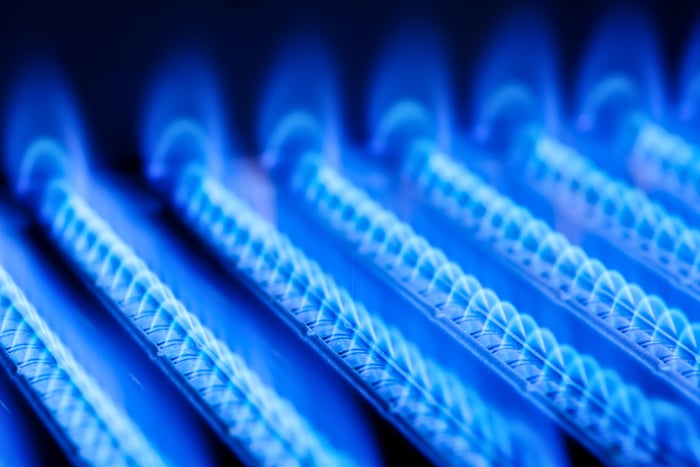
In America, gas tends to be cheaper than electricity, so you might be inclined to think that going for the former fuel type is the way to go to save a fortune. However, there are many other factors you must take into consideration.
Gas ovens often require more maintenance and due diligence when used. Not only to prevent dangerous leaks and fires but also to ensure that the unit has a long lifespan.
On the other hand, electric ovens tend to be more forgiving when it comes to maintaining them, which means that you’ll likely spend less on spare parts and technician visits than a gas variant.
On average, gas ovens use around .65 gallons (0.25 m³) of LP gas per hour, whereas electric ovens use about 2,500 watts in the same period.
Features
Features are also key when looking into purchasing a new oven for your home. Now that we’ve covered estimates for the price, recommended compartment capacity, and different fuel types, let’s touch on what your money will be buying.
Depending on the oven type you choose, you’ll enjoy more or fewer features, and the price will rise or drop according to this.
But please, don’t throw away your money! Unless you’re a professional chef or a passionate hobbyist baker, you can achieve most of your goals with an average unit.
Here are some of the most significant features of each oven type to help drive your decision:
| Oven Type | Key Feature(s) |
| Range Oven | Versatility and integration of a cooktop & the oven. |
| Wall Oven (Single) | Seamless integration with your kitchen’s cabinetry. Ideal for people looking for an aesthetic look. |
| Wall Oven (Double) | Shared features with the Single variant, but offering more space for additional batches. |
| Convection Oven | Distinctive air circulation method that ensures even cooking. |
| Smart Oven | Remote control, and preprogrammed recipes. Offers independence for the user. |
| Air-Frying Oven | Typically integrated with several other cooking methods in a single appliance. Yields less-dense calorie meals with similar results to deep-frying. |
| Steam-Oven | Preserves moisture in meals, great for reheating. Superior energy efficiency and shorter cooking times. |
Efficiency
Efficiency is often overshadowed by other, more seemingly important elements when looking for the perfect new oven. However, it shouldn’t be.
Considering the price tag of an appliance you’re interested in and comparing it to the features it offers to determine its value is wise. However, if you also fail to consider how much you’ll be paying to use the appliance every month, you might end up with an unpleasant surprise.
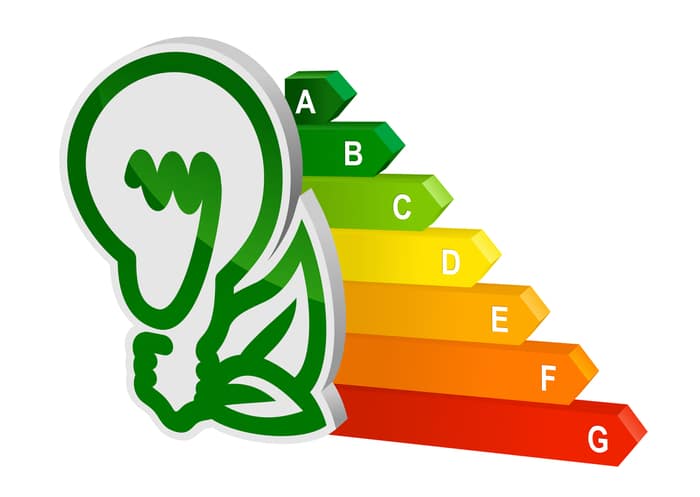
As opposed to refrigerators and other major appliances, there are no ovens meant for residential use that have an “Energy Star” rating, which is a certification that ensures appliances are designed as efficiently as possible.
That said, the lack of an Energy Star rating doesn’t mean all ovens are inefficient. There are great options out there that can save you hundreds of dollars every year.
If you want a lower cost increase on your monthly bills, a gas-fueled model should be your go-to. However, if you’re convinced that you want an electric unit for easier maintenance, make sure that you look for a model that uses no more than 2500 watts per hour.
Manufacturer & Warranty
Manufacturer & warranty should also be at the top of your listing during the purchasing process, as they will greatly determine how much you’ll be paying for repairs and other services over the years.
Good habits while using the oven also matter, but they’re just one piece of a larger puzzle.
Buying an oven or any other major appliance from a reputable vendor and brand is always recommended. Most popular companies have been around for decades, and their survival clearly indicates the quality they offer in their products.
This is not to say that famous manufacturers are perfect. Even high-quality appliances can fail now and then or have factory defects, so looking for an oven with a good, long warranty is essential.
Here’s a table including 5 of the most popular oven brands in America:
| Brand | Warranty Length |
| General Electric (GE) | 1 Year |
| Whirlpool | 1 Year |
| Frigidaire | 1 Year |
| Samsung | 1 Year |
| LG | 1 Year |
Honorable Mentions
As a bonus, I also wanted to include some top-notch models to give you a wider view of just how expensive premium ovens can be. While you’ll be extremely hard-pressed to see units in the +$15,000 range in homes, many Michelin Star restaurants use them, and maybe even some millionaire chefs have them in their kitchens.
One of the world’s most famous custom-built cooking station manufacturers is La Cornue – well known for offering an oven station worth a whopping $500,000!
That’s right; there are ovens worth almost two times more than the average home in Texas.
Choosing Your Oven
So, now that you have all the information you need to decide on what oven to buy – which oven type is best for you?
Well, there’s no cookie-cutter answer, as everyone has different needs. However, considering the number of people you live with, your baking habits, and your monthly budget for utilities can go a long way in making the right choice.
Most people who only want an oven to cook for their family without overcomplicating things with hundreds of features should be pleased with a standard range or wall unit.
Thanks for reading. If this article has helpful, please check out our other resources and free guides below and consider subscribing to our newsletter.
Happy shopping!
-Craig.
Frequently Asked Questions
What Are Some Premium Oven Brands?
There are many reputable oven brands out there that offer high-quality materials, modern features, and attractive warranties. Other than the most famous manufacturers mentioned above, companies like WOLF, Chef’s, and SMEG have also made a name for themselves, especially in the high-end tier.
Are Electric Ovens Better Than Gas?
It varies from person to person. If boiled down to basic power consumption, gas ovens are cheaper than electric ones. However, gas ovens also pose a greater fire hazard.
Also, electric ovens need less maintenance and are never at risk of being the source of a gas leak. Electric ovens are easier to keep in good condition overall, and many people prefer to pay a little extra in utilities for safer appliance use.
How Much Does a Wall Oven Installation Cost?
Wall oven installation costs depend on the hourly rate of the contractor you hire to do the job, the materials in your kitchen, and several other factors. However, the average project cost hovers around the $1,800-2,000 mark after considering labor and materials.






